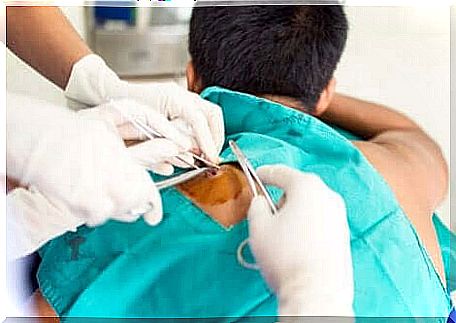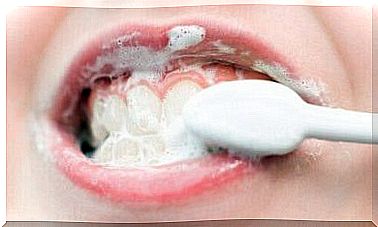Benign Tumors: Everything You Need To Know About Them

Benign tumors are a number of skin diseases with varying causes. Their classification is often based on the area in which they occur, size, color, distribution, and other symptoms. In general, they do not cause concern other than aesthetic change.
According to an article in the Journal of Cutaneous and Aesthetic Surgery, these skin changes occur when one or more agents are present on the skin. Although benign tumors are usually not severe, it is recommended that you consult a dermatologist to ensure a correct diagnosis. Want to know more about this topic? Keep reading!
Why do benign tumors form?
Like all tumors, a benign tumor is a mass of abnormal cells. What sets them apart from malignancies, however, is that they do not affect the surrounding tissues or spread to other parts of the body.
Tumors of this type are surrounded by a protective capsule that facilitates their removal. Blood tests, imaging methods (such as an x-ray) or a biopsy will help determine if the tumor is malignant or benign.

Different types of benign tumors
Most people experience a wide variety of skin changes during their lifetime. Physicians with appropriate training and experience will be able to classify most of these skin changes using clinical research.
Adenoma
Adenoma is a benign tumor of the superficial tissue that arises from the sebaceous or sweat glands. Common examples are:
- Fatty adenoma
- Apocrine tubular adenoma
- Hydradenoma
Fibrooma
Dermatofibroma is one of the most common soft tissue skin tumors. In fact, it represents about 3% of the samples received by dermatopathological laboratories.
If classical clinical as well as pathological symptoms are present, diagnosis is usually easy. It is common in middle-aged adults and occurs slightly more in women than men. These tumors are often located in the limbs and appear as small, elevated, hyperkeratotic nodules of the skin with a reddish-brown surface.
Lipoma
Patients with lipoma often complain of a soft, moving mass of tissue that is felt under the skin. Tumors are usually painless unless they penetrate joints, nerves, or blood vessels.
They are usually benign and have no risk of malignant change. The forecast is very good. Once the lipoma is removed, it usually does not recur. However, it is necessary that the fibrous capsule surrounding the lipoma be completely removed to prevent recurrence.
Myoma
Leiomyomas are benign tumors of smooth muscle and are most common in the uterine wall, gastrointestinal tract, skin, and lower extremities of middle-aged women.
Clinical connective tissue tumors, such as fibroids and lipomas, are symptomatic of myoma. It is therefore important to distinguish between similar diseases on the basis of biopsies.
Osteochondroma
Osteochondromas are common; they actually represent 20-50% of all benign bone tumors. They can be single or occur in small clusters. The prognosis for individual tumors is good, and a malignant change occurs in only about 1 percent of cases.
Most individual tumors are small and asymptomatic. However, the diagnosis and treatment of this skin disease requires the collaboration of different health care professionals.
Mole
The eyelids are pigmented skin lesions. They can occur from birth and can become malignant if a person is repeatedly exposed to the sun’s UV radiation without proper sun protection. In addition to the AE assessment of the properties of pigmented lesion, the study of the created ones is guided by specific dermatoscopic methods.
We recommend using sunscreen and checking your eyelids regularly to avoid developing melanoma. Excessive use of the tanning bed should also be avoided.
Symptoms of benign tumors
Some benign skin tumors are completely asymptomatic. However, due to their size, they can be easily detected by palpation. Other common symptoms include:
- Pain in surrounding tissue
- The surface of the skin is elevated
- Tingling, tingling or numbness
- Itch
Correct diagnosis of benign tumors
In most cases, when a patient goes to remove a tumor, the surgeon removes both the tumor and a small piece of normal tissue around the tumor. This will also help in making a final diagnosis. Some benign tumors may recur if surgery fails and not all of the tumor tissue can be removed.
In addition, many skin tumors cannot be properly examined from the surface of the skin and can be diagnosed as benign skin tumors without adequate examination.
According to an American Family Physician source, all tumors with an uncertain diagnosis should be removed for further investigation. This is to prevent the development of malignancies .

What are the treatment options?
The treatment of benign tumors is usually for aesthetic reasons. If deemed necessary, methods of treatment range from simple surgical removal of a single tumor or tumor cluster to Mohs micrographic surgery from anatomically critical sites.
There are also more drastic treatment options. Before using these therapies, the doctor will evaluate the pros and cons of the treatment and the patient’s recovery. Alternative therapies include:
- Removal with scissors or razor blade
- Curettage with Electrodisection (Electrosurgery)
- Skin consumption
- Chemical treatment with salicylic acid
- Radiotherapy
- Laser surgery and cryotherapy
Dermatologist consultation
Benign tumors usually do not cause major problems or pose a risk to a person’s health. Nevertheless, it is important to see your dermatologist regularly. In this way, the development of serious problems can be avoided.
Fortunately, there is a wide variety of different treatment options to remove tumors when they are aesthetically disruptive. Your dermatologist can help you choose the best treatment for you.









